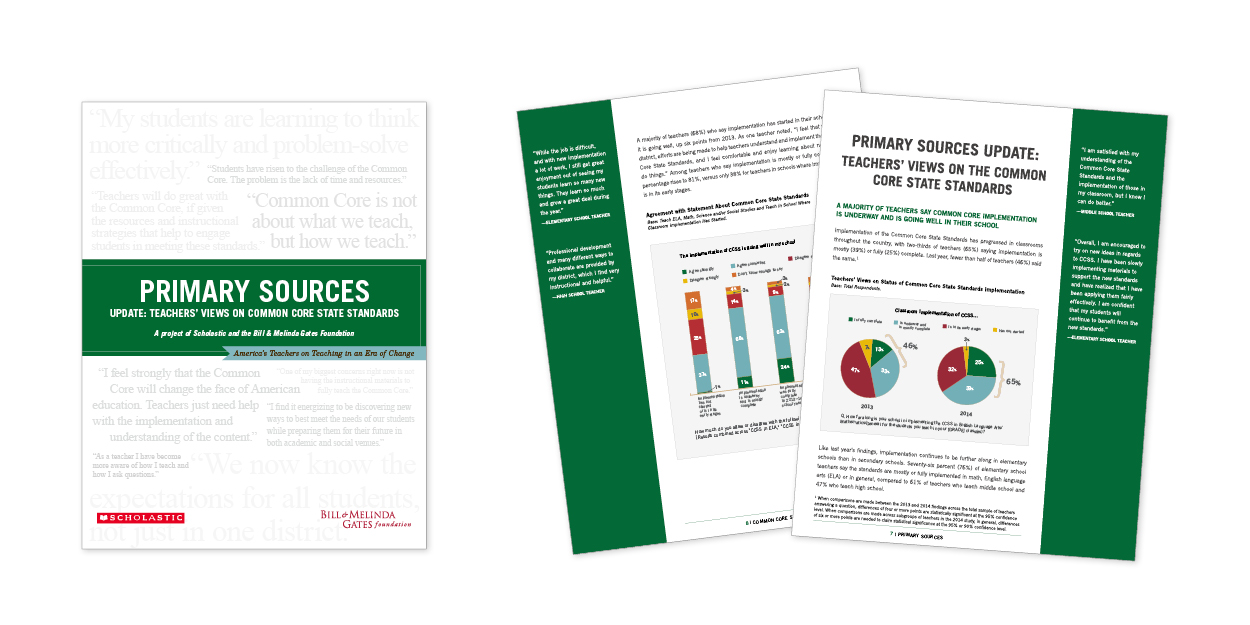Primary Sources

“Teachers will do great with the Common Core if given the instructional strategies that help to engage students in meeting these standards.”
—— Elementary School Teacher
Press Releases
- Survey Provides First-Hand Look at How One Year Has Affected Teachers' Views on the Common Core State Standards
- 20,000 Teachers Provide Powerful Insights on Teaching in an Era of Change in New Primary Sources Survey
Hightlights from 2014 Primary Sources Update: Teachers' Views on the Common Core State Standards
Fielded in July 2014
- In 2014, more teachers feel prepared to teach to the Common Core (79% in 2014 vs. 71% in 2013) and are more likely to say implementation is going well in their schools (68% in 2014 vs. 62% in 2013).
- 53% of teachers overall have seen a positive impact on their students’ ability to think critically and use reasoning skills due to Common Core implementation. 68% of teachers who report they are in schools where implementation was fully complete in the 2012–13 school year or earlier, say the same.
- 84% of teachers who have experienced more than one year of full implementation say they are enthusiastic about the implementation of the new standards.
- Fewer teachers overall this year than last say that they are enthusiastic about Common Core implementation (68% in 2014 vs. 73% in 2013); teachers are now also more likely to say implementation is challenging (81% in 2014 vs. 73% in 2013).
- Teachers continue to need support and resources, identifying Common Core–aligned instructional materials (86%), quality professional development (84%), additional planning time (78%) and opportunities to collaborate (78%) as critical to ensure successful implementation.
“I believe that the Common Core has helped me think differently about how I can present information to my students, and how I can help them acquire and retain knowledge.” — MIDDLE SCHOOL TEACHER
Highlights on Teaching, Evaluations and Collaboration from the Full Third Edition
Fielded in July 2013
Teachers Bring Passion and Commitment to Their Challenging Work
- Nearly every teacher (98%) agrees that teaching is more than a profession; it is how they make a difference in the world—one child at a time.
- 99% of teachers see their roles extending beyond academics to include things like reinforcing good citizenship, building resilience and developing social skills.
- Constantly changing demands on both students and teachers is the number one challenge most cited by teachers (82%).
- Overall, 88% of teachers agree the rewards of teaching outweigh the challenges.
“When you get those mini victories and you see that a child is learning and something positive is happening as a result of your time in your classroom, that’s a big deal.” — MIDDLE SCHOOL TEACHER
- Nearly all (99%) teachers are evaluated at least once every few years, with 79% evaluated at least once a year.
- Similarly, 99% of teachers say they should receive a formal evaluation of their practice at least once every few years, with 77% saying they should receive a formal evaluation at least once a year.
- Most teachers (78%) say they find their evaluations somewhat, very or extremely helpful in refining or improving their practice; 69% receive feedback to refine or improve their practice.
- Teachers who do not find their evaluations very or extremely helpful share that they desire more actionable feedback (42%), increased fairness in the evaluations process (30%) and more—and better-qualified—evaluators and observers (23%).
“I wish that teachers could receive feedback on a regular basis that was a narrative of what we are doing well and where we need to grow.” — MIDDLE SCHOOL TEACHER
Teachers Seek to Collaborate In and Outside of School to Best Serve Students
- Teachers say time collaborating with colleagues is most often spent exchanging/sharing resources and lesson plans (76%) and learning from each other’s successes and challenges (68%).
- Teachers’ online collaboration often mirrors in-person collaboration, with 91% using websites to find or share lesson plans or other classroom content, 65% using websites for professional advice and support and 57% using websites to collaborate with teachers with whom they wouldn’t otherwise have had the opportunity.
- To create communities of support for their students, teachers actively build school-to-home connections with families and colleagues, both in school and online, with 95% of teachers encouraging parents of their students to reach out to them with questions and concerns.
- When asked about strategies for parents to engage in to help ensure their child succeeds in school, 98% of teachers say making sure a child misses as little school as possible is very or extremely helpful, followed closely by setting high expectations for their child (97%) and working in partnership with teachers when their child has challenges (97%).
“While some may say we can’t control out-of-school factors, we can definitely begin an educational dialogue with parents and guardians in order to get on the same page about the education of their children.” — HIGH SCHOOL TEACHER
2013 State-by-State Data
View highlighted data by state here.
Note: State-by-state data for 2014 is not available due to smaller overall sample size.
Downloads
- 2014 Primary Sources Update Infographic
- Teaching and Technology Infographic
- A Portrait of America's Teachers Infographic
- Primary Sources: America's Teachers on Teaching in an Era of Change Infographic
Past Reports
- Primary Souces: America's Teachers on Teaching in an Era of Change–Common Core State Standards Preview (2013)
- Primary Sources: America’s Teachers on the Teaching Profession with Full Appendix (2011)
- Primary Sources: America’s Teachers on the Teaching Profession without Appendix (2011)
- Primary Sources: America’s Teachers on America’s Schools (2009)
- Primary Sources: America’s Teachers on America’s Schools: State Level Data (2009)
With data for CO, DE, FL, GA, IL, KY, LA, MA, NC, NY, OH, PA, RI, SC, TN)
